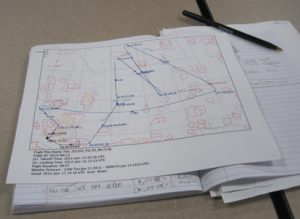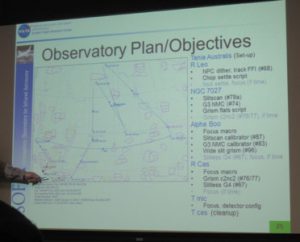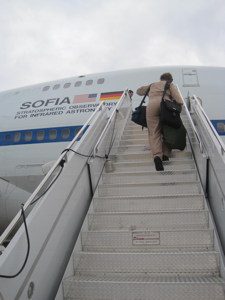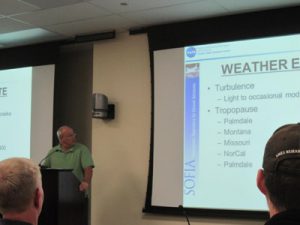Reposted from https://blogs.nasa.gov/mission-ames/2013/06/12/post_1371062862409/.
I’ve just completed my first flight on the StratosphericObservatory for Infrared Astronomy, SOFIA. Wow! What an interesting experience. I’ll break down my comments on this first flight into several shorter blogs.
When I awoke late morning (as I was trying to get onto a night shift), I obtained the list of targets planned for tonight’s flight. We are still commissioning these “modes” on SOFIA so we chose bright, standard objects that have been observed regularly by other instruments over the years.
Tonight’s targets were R Leo (a red giant star), NGC7027 (a planetary nebula), alpha Boo (also known as Arcturus, a K1.5 IIIpe,orange giant star), R Cass (M-type, red giant variable star of MiraCet type) and T Mic (a M7-III giant, semi-regular pulsating star). The targets were taken from a list of calibrators we assembled and chosen because they were visible to a USA-domestic flight plan for SOFIA for the middle ofJune. If we flew at another time, we would have used other similar type objects. But these five objects would be our guides on this flight.
With the target list came a list of the specific measurements we planned to make on each target. We’ve had to deviate from the original planI helped write months ago, only because the two previous flights had been cut short. So this revised plan tackled the largest holes we needed to address.
At 5:25pm local time, I attended the Crew Briefing. Here theMission Director Charlie Kaminski did a roll call of all the people to fly aboard SOFIA tonight. There were 5 staff (pilot, co-pilot, flight engineer and two safety techs), three telescope operators (only two are needed, and one was in training), the FORCAST science instrument support team (for both imaging and grism modes, about 9 of us), Dana Bachman (SOFIA EPO lead) and 4 SOFIA Airborne Ambassadors, Beth Hagenauer (NASA Dryden PAO) who was shepherding a television crew (about 4-5 people), Tom Rolling (NASA Ames) who ran an EMI test between his water vapor monitor facility and the FORCAST instrument, the support staff for the on-board MCCS system, and the Mission Director and Flight Planner. All in all, thee were about 30 folks on this flight, a complement typical for these early flights where lots of activities are occurring simultaneously.
 Flight Plan for SOFIA Flight 105 as presented during the Pre-Flight Briefing.
Flight Plan for SOFIA Flight 105 as presented during the Pre-Flight Briefing.
Next we had a briefing about the weather, with emphasis on expected areas of turbulence. Granted it’s never clear when you will hit uneven air, but it was a good mental exercise to think through each flight leg to see what might get dropped if the turbulence got too rough to control the telescope. So we were expecting to have “weather” when we flew over northern Montana, Nebraska and Missouri due to the summer thunderstorms. The timeline from doors closed to data transfer at end of flight was discussed. And each key system: aircraft, telescope, and science instrument, reported on their readiness.
Upon inspection of the flight plan, it was remarked “You are all going into Canada” and we all inspected that yes the transition from Leg 8to Leg 9 did cross at the Montana/Canadian boarder. In flight, the Flight Planner actually announced around 12am PDT (07:00 UTC) when SOFIA entered into international airspace, even if just for a few minutes. That was very cool, eh?
Mapping of observational targets/objectives to each flightleg.
A SOFIA flight is highly orchestrated. For this particular flight, as we were using specific targets for calibration, we dedicated single legs to one object. Within minutes after the crew briefing ended, it was time to walk over to SOFIA, which had been moved out onto the tarmac, and climb aboard!
We board SOFIA from the taxi-way. The plane had been refueled and ready to go hours before our take-off.
Oh, a special surprise! A friend from a leadership development program we did together about 3 years ago (my, has time flown!), Ed Teets, a meteorologist & atmospheric physicist from NASA Dryden, came to give the pre-flight weather briefing. That was awesome Ed!
My friend Ed Teets, atmospheric physicist, from NASA Dryden given the weather briefing for SOFIA Flight #105.



